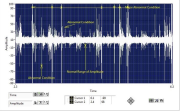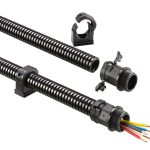 It has been established that ultrasound monitoring provides early warning of bearing failure. Various stages of bearing failure have been established. An 8 dB gain over baseline indicates pre-failure or lack of lubrication. A 12 dB increase establishes the very beginning of the failure mode. A 16 dB gain indicates advanced failure condition while a 35-50 dB gain warns of catastrophic failure. For those who utilize ultrasound spectral analysis, these conditions can often be observed through both Fast Fourier Transform (FFT) and time series analysis.
It has been established that ultrasound monitoring provides early warning of bearing failure. Various stages of bearing failure have been established. An 8 dB gain over baseline indicates pre-failure or lack of lubrication. A 12 dB increase establishes the very beginning of the failure mode. A 16 dB gain indicates advanced failure condition while a 35-50 dB gain warns of catastrophic failure. For those who utilize ultrasound spectral analysis, these conditions can often be observed through both Fast Fourier Transform (FFT) and time series analysis.
This is possible using an ultrasound instrument and special sound analysis software. UE Systems Ultraprobe 10000 and Ultraprobe 15000 are able to do sound recordings that can be later analysed in its license-free software Spectralyzer.
Good Bearing in FFT view
This is the Fast Fourier Transform (FFT) of a good bearing. Since there are no defects, the sound will be a smooth rushing sound. The FFT spectrum view will not show any harmonics or large peaks.
https://www.youtube.com/watch?v=DYMZACudMyE
Bad slow speed bearing in Time Series view
This is a Time Series view of a bad slow speed bearing (less than 25 RPM). The heterodyned audio signal we can listen to gives us already a clear indication of bad condition. When analyzing slow speed bearings it may be difficult to get a good reading in FFT view. However, the defects are very apparent in the Time Series view.
https://www.youtube.com/watch?v=HD_ChuKZEBg
Bad bearing in FFT view
This is an FFT spectrum view of a bad bearing. As a bearing enters the failure stage there is a rise in the decibel level of 12- 16 dB over a baseline. This rise in amplitude is usually accompanied by a change in the sound quality. Note that on this bearing we can now observe fault frequency harmonics which we can use to confirm & analyse. The integrated bearing fault calculator can confirm inner/outer ring, ball pass or cage defects.
https://www.youtube.com/watch?v=oQh_quwaG0M
Predictive & pro-active inspection of rotating equipment with an ultrasonic instrument such as the Ultraprobe has many advantages. An ultrasound bearing inspection program provides:
- Early warning of bearing failure
- Detecting a lack of lubrication
- Preventing over-lubrication
- Advanced software to assist your work process & analyses very efficiently
 Ultrasound can be used on all bearing speeds (high, medium and low). In addition, since ultrasound is a high frequency, short wave signal, it is possible to filter out stray, confusing background noises and focus on the specific item to be inspected. Basic inspection methods are extremely simple and require little training.
Ultrasound can be used on all bearing speeds (high, medium and low). In addition, since ultrasound is a high frequency, short wave signal, it is possible to filter out stray, confusing background noises and focus on the specific item to be inspected. Basic inspection methods are extremely simple and require little training.
Find more about bearing inspection using ultrasound technology.





